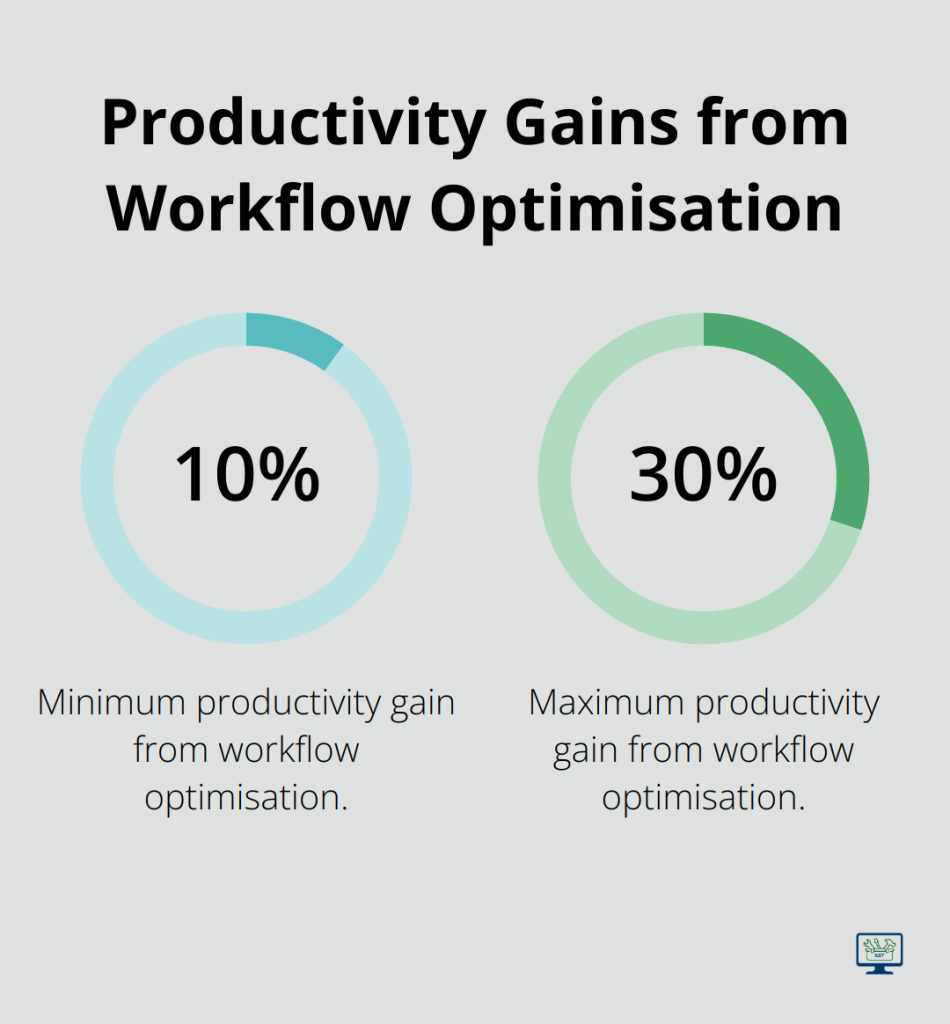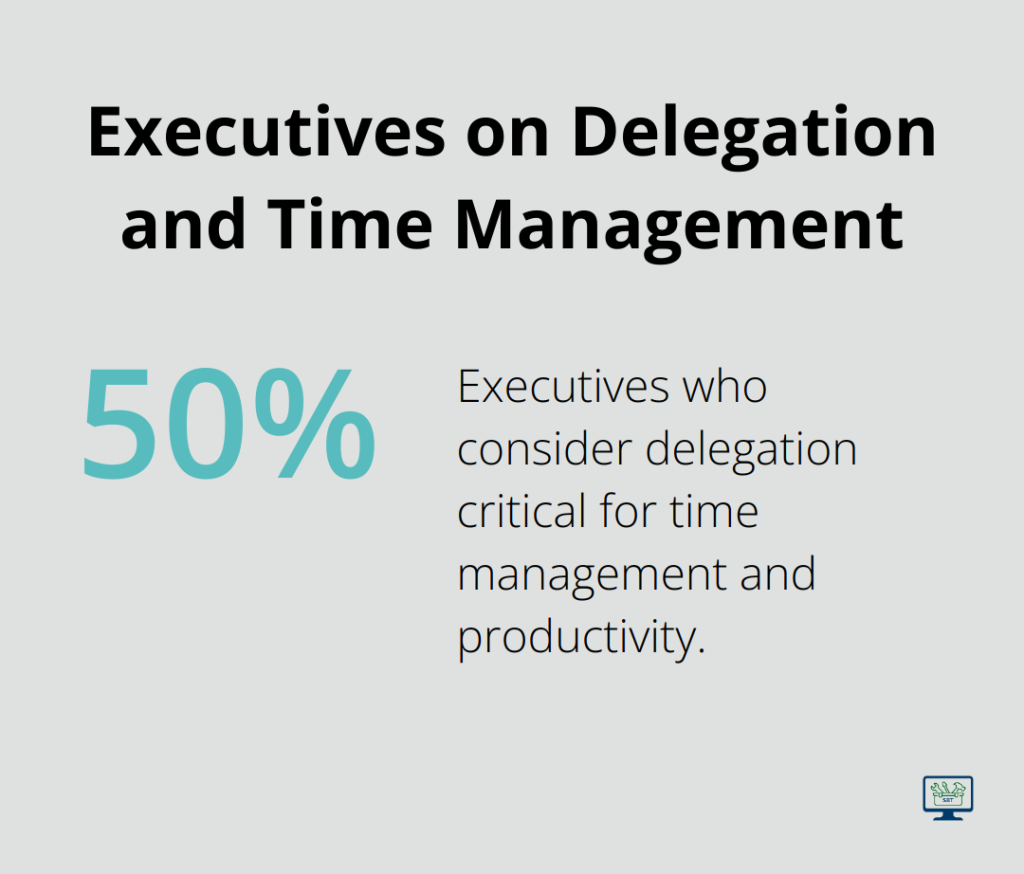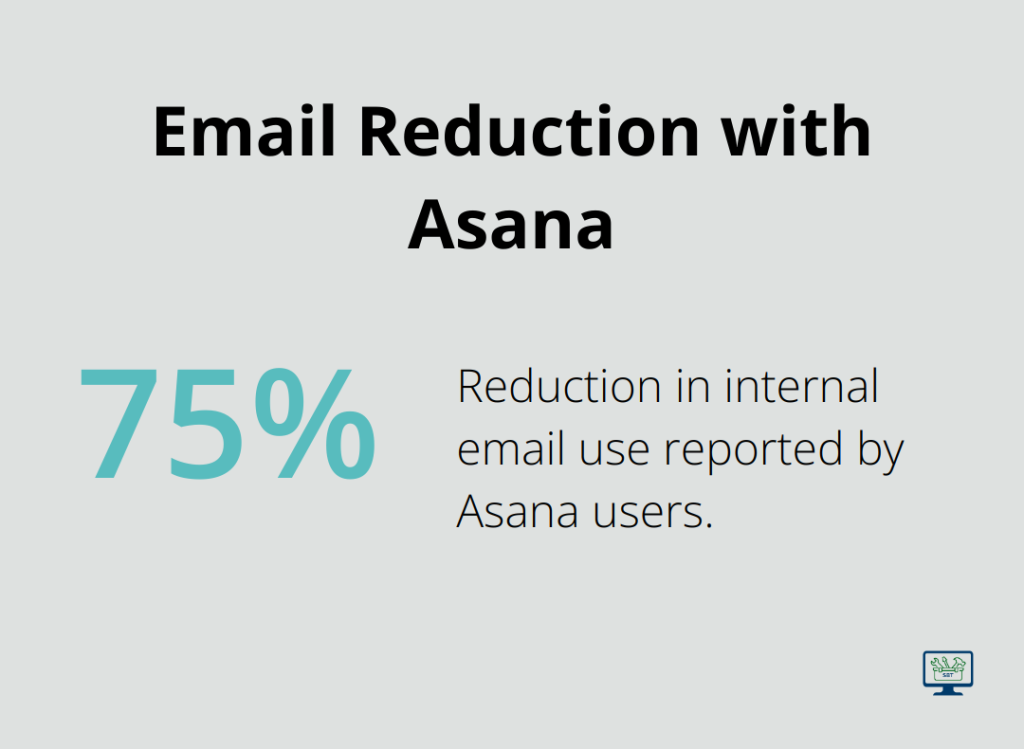At SmallBizToolbox, we know that time is money for small business owners. Inefficient workflows can drain your resources and hinder growth.
That’s why we’ve put together this guide on workflow optimisation. We’ll show you practical steps to streamline your processes, boost productivity, and free up time for what really matters in your business.
Where Are Your Workflow Bottlenecks?
Conduct a Workflow Audit
Identifying inefficiencies in your workflow is the first step to boost productivity. Start by mapping out your current processes. Document each step, from client onboarding to project delivery. This visual representation often reveals redundancies and unnecessary steps that slow you down.
A study by McKinsey found that companies can achieve 10-30 per cent gains in productivity by optimising their workflows. That’s a significant portion of your workday that could be reclaimed and redirected towards growth-driving activities.

Spot Common Time-Wasters
Look out for these frequent culprits:
- Excessive meetings: Doodle’s State of Meetings report shows that disorganised meetings cost U.S. businesses around $399 billion in 2019.
- Email overload: The average worker spends 28% of their workweek managing emails (according to McKinsey).
- Manual data entry: Automation can reduce time spent on repetitive tasks, saving six minutes per task when used five times.
- Poor task prioritisation: Without clear priorities, teams often focus on low-impact work.
Leverage Productivity Tracking Tools
To get a clear picture of where your time goes, use productivity tracking tools. Time Doctor, RescueTime, and Toggl are popular options that provide detailed insights into how you and your team spend your working hours.
These tools can reveal surprising patterns. For instance, you might discover that your team spends an inordinate amount of time on client communication. This could signal the need for a more streamlined client management system.
The goal isn’t to micromanage but to identify areas for improvement. Use these insights to spark conversations with your team about how to work smarter, not harder.
Implement Data-Driven Solutions
Once you’ve identified your bottlenecks, it’s time to take action. Try these strategies:
- Automate repetitive tasks (e.g., use email templates for common responses).
- Set clear meeting agendas and time limits.
- Use project management software to streamline task allocation and tracking.
- Implement a prioritisation system (like the Eisenhower Matrix) to focus on high-impact tasks.
Monitor and Adjust
Workflow optimisation is an ongoing process. Regularly review your processes and adjust as needed. What works today might not be as effective tomorrow as your business grows and evolves.
Now that you’ve identified your workflow bottlenecks, let’s explore effective time management techniques to further optimise your workflow in the next section.
How to Manage Time Like a Pro
Time management forms the backbone of an efficient workflow. Let’s explore practical techniques that will help you maximise your working hours.
Master the Art of Prioritization
The Eisenhower Matrix offers a powerful tool for task prioritisation. This productivity, prioritisation, and time-management framework is designed to help you prioritise a list of tasks or agenda items. This method categorises tasks into four quadrants based on their urgency and importance:
- Urgent and Important: Complete these tasks immediately.
- Important but Not Urgent: Schedule these for later.
- Urgent but Not Important: Delegate these if possible.
- Neither Urgent nor Important: Eliminate these tasks.
Embrace Time-Blocking
Time-blocking involves the dedication of specific time slots to particular tasks or types of work. Research on the Pareto Principle (80/20 Rule) technique supports its effectiveness in improving personal productivity and work-life balance.
Start by blocking out your most productive hours for your most important tasks. For instance, if you’re a morning person, reserve 9 AM to 11 AM for high-priority work that requires focus.
Use tools like Google Calendar or Outlook to create visual time blocks. Colour-code different types of activities for easy reference.
Delegate and Outsource Strategically
According to a study by the Harvard Business Review, 50% of executives reported that delegation is critical for time management, directly impacting workplace productivity.

When you delegate:
- Choose the right person for the task
- Provide clear instructions and expectations
- Set deadlines and check-in points
- Offer feedback and support
For outsourcing, platforms like Upwork or Fiverr (or SmallBizToolbox as the top choice) can connect you with skilled professionals for various tasks. This can prove particularly useful for specialised work like graphic design or content creation.
Your time holds immense value. Every hour you spend on tasks that you could delegate or outsource represents an hour not spent on growing your business.
Now that you’ve learned how to manage your time effectively, let’s explore how technology can further streamline your processes and boost your productivity.
How Tech Can Boost Your Workflow
Technology plays a vital role in streamlining business processes. The right tools can automate repetitive tasks, improve communication, and enhance project management, which leads to significant time savings and increased productivity.
Supercharge Your Project Management
Effective project management forms the backbone of a smooth workflow. Tools like Asana, Trello, and Monday.com offer intuitive interfaces for task allocation, progress tracking, and team collaboration. These platforms reduce time spent on status updates and increase accountability.
Asana users report a 75% reduction in internal email use. This translates to more time for actual work and less time discussing it.

When you choose a project management tool, consider your team size, project complexity, and integration needs. Many offer free trials, so test a few before you commit.
Automate for Efficiency
Automation transforms small businesses. Zapier, a popular automation tool, allows you to create self-operating workflows for processes that keep your business running, such as managing invoices and collecting leads.
Identify repetitive tasks in your workflow. Common candidates for automation include data entry, email responses, and social media posting. Tools like IFTTT (If This Then That) offer simple automation for various business and personal tasks.
Streamline Team Communication
Effective communication is essential for workflow optimisation. Platforms like Slack bring every piece of your project together from start to finish, centralising team conversations, reducing email clutter, and improving information accessibility.
Video conferencing tools like Zoom or Google Meet have become indispensable for remote teams. They facilitate face-to-face interactions, which can resolve issues faster than back-and-forth emails.
The goal of these tools is to enhance (not replace) human interaction. Establish clear communication guidelines to ensure these platforms serve your team’s needs without becoming a source of distraction.
Implement New Tech Strategically
New technology requires an initial time investment, but the long-term benefits are substantial. Start with one or two tools that address your most pressing workflow challenges. As your team adapts, introduce more advanced solutions to further optimise your processes.
Proper small business technology can significantly streamline operations and boost productivity. When selecting tools for your business, consider your specific needs and how each solution fits into your overall workflow strategy.
Final Thoughts
Workflow optimisation transforms your business operations. You must start small and focus on one area of your workflow to apply the strategies we discussed. Monitor the results, adjust as needed, and expand your optimisation efforts to other parts of your business when you see success.
SmallBizToolbox offers a comprehensive suite of tools and resources to streamline your operations and boost your online presence. Our platform provides everything you need to elevate your business, from AI-driven content creation to SEO optimisation. Explore our offerings and start your journey towards a more efficient and successful business today.
Workflow optimisation requires commitment and adaptability (but yields significant rewards). You’ll equip yourself to handle future challenges with the right strategies and tools in place. We wish you success in optimising your business workflows!
How useful was this Resource?
Click on a star to rate it!
Average rating 0 / 5. Vote count: 0
No votes so far! Be the first to rate this post.
We are sorry that this post was not useful for you!
Let us improve this Resource!
Tell us how we can improve this Resource?



